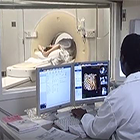Non-Physician Practitioners Use Contrast-Enhanced CT More Often Than Physicians
 When non-physician practitioners (NPPs) perform a higher share of patient evaluation and management (E&M) visits, computed tomography (CT) imaging is more likely to use iodinated contrast media. The new Harvey L. Neiman Health Policy Institute study revealed that for each 10% increase in visits performed by an NPP rather than a physician, there was 4.5% higher utilization of contrast media for ordered CT studies. The study, published in the Journal of the American College of Radiology, was based on an evaluation of a 100% sample of Medicare fee-for-service professional claims between 2011 and 2020.
When non-physician practitioners (NPPs) perform a higher share of patient evaluation and management (E&M) visits, computed tomography (CT) imaging is more likely to use iodinated contrast media. The new Harvey L. Neiman Health Policy Institute study revealed that for each 10% increase in visits performed by an NPP rather than a physician, there was 4.5% higher utilization of contrast media for ordered CT studies. The study, published in the Journal of the American College of Radiology, was based on an evaluation of a 100% sample of Medicare fee-for-service professional claims between 2011 and 2020.
The new study found the share of E&M visits performed by an NPP (nurse practitioner or physician assistant) increased from 6.5% in 2011 to 14.7% in 2020. This trend mirrors results of another Neiman Institute study published earlier this month in JAMA Network Open that found growth in NPPs as emergency department (ED) providers and an associated increased use of advanced imaging in this setting.
“The recent contrast media shortage created a need to identify opportunities to reduce lower value utilization of contrast in CT imaging. Given that NPPs are associated with more imaging utilization in the ED, we wanted to see if these providers also order more contrast-enhanced imaging than physicians, across settings,” explained Elizabeth Rula, PhD, Executive Director of the Neiman Institute.
“For a 10-percentage-point increase in NPPs relative to physicians as E&M providers, we found an associated increase in CT contrast media orders in the outpatient hospital (4.5%), inpatient (11.9%), and office (12.1%) settings, but not in the ED,” said Eric Christensen, PhD, Research Director at the Neiman Institute and lead author of the study. “Similarly, there was more CT contrast media ordered for imaging studies of the chest (9.2%), abdomen/pelvis (3.5%), and spine (34.2%) with a higher share of NPPs; contrast use in other body areas were not significantly higher.”
“Across most settings and body regions contrast media use increased significantly with a higher share of E&M visits to NPPs. Conversely, we observed no negative associations, where higher physician ordering resulted in a greater likelihood of CT with contrast,” stated Andrew Rosenkrantz, MD, MPA, a study co-author, professor and director of health policy in the department of radiology at NYU Grossman School of Medicine. “Our study cannot determine if imaging was appropriately used by NPPs or physicians, but the observed variation in care patterns by practitioner type highlights the need to establish systems to ensure the appropriateness of imaging ordered.”